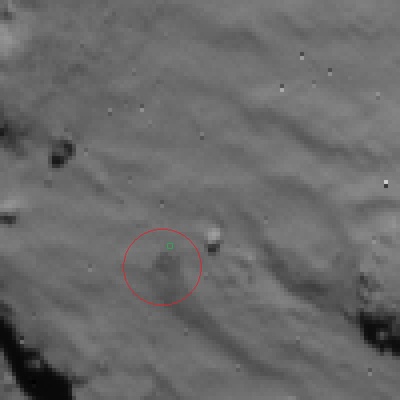Philae’s first touchdown seen by Rosetta
The animation comprises images recorded by the navigation camera (NAVCAM) on board Rosetta as the orbiter flew over the (intended) Philae landing site on 12 November.
The images were taken at
- 2014-11-12 T15:30:32 UTC
- 2014-11-12 T15:35:32 UTC
The landing time was 2014-11-12 T15:34:06 UTC onboard the spacecraft, between the timestamps of the two images.
The first image is thus 3 min 34 sec before touchdown. At this time, Philae was approximately 250m above the surface.
The second image is 1 min 26 seconds after first touchdown. The touchdown is seen as a dark area. This dark area could be considered as strong indication that the lander touched down at this spot (possibly raising dust from the impact). The third image is the same as the second, but also shows a green square; this is the computed touchdown point.
They were taken from a distance of about 15 km from the surface, giving an approximate scale of 1.3 m per pixel. The dark spot appears to be within less than 10 m of the computed touchdown point.
You can also clearly see the boulder identified in the ROLIS images just to the top right of the circle. In all images there are pairs of pixel artefacts (not the lander!).
With thanks to Emily Lakdawalla of the Planetary Society for helping with the image processing.
